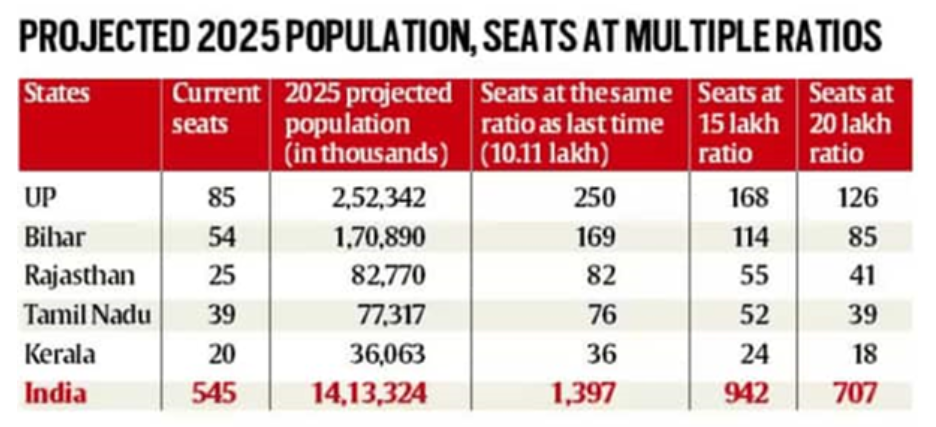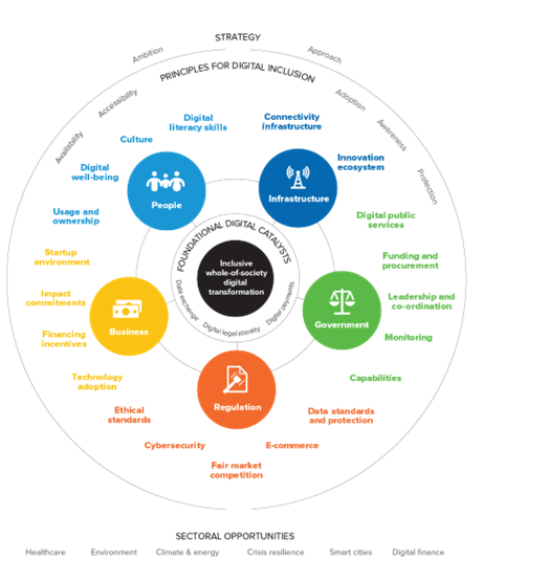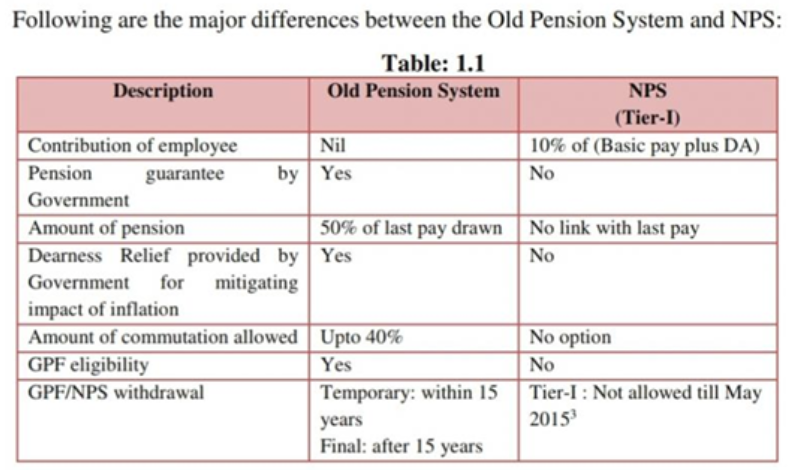Wednesday, 27th September 2023
Suicide Clusters in India - Edukemy Current Affairs
In News: The suicide cluster in Kota is being referred to as a public health emergency. The total suicide victims in 2023 alone has touched up to 26 in Kota.
About Suicides in India:
- Suicide is a deliberate act of self-harm that leads to death. It is a complex issue with many contributing factors, including mental illness, substance abuse, relationship problems, and financial hardship.
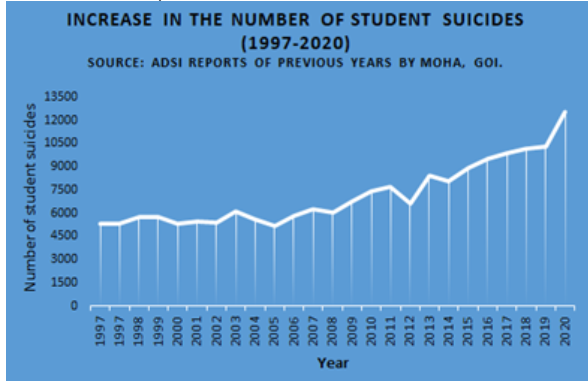
- There has been a rising trend in number of suicides in India. The city of Kota in Rajasthan, has witnessed a notable rise in suicides, particularly among students preparing for examinations making it a suicide cluster.
- US’s Centres for Disease Control and Prevention defines a suicide cluster as a group of suicides, suicide attempts, or self-harm events that occur closer together in time and space than would normally be expected in a given community.
Emergence of Kota as suicide cluster:
- Point cluster: The situation in Kota is identified as a suicide cluster, specifically a point cluster, where suicides are occurring closer together in time and space than otherwise.
- Contagion effect could also be witnessed where one person’s suicide, due to its circumstances and the publicity around it, triggers the risk of suicidal ideation, suicide attempts and/or deaths by suicide in others who are already vulnerable to suicidal thoughts, leading to suicide clusters.
- Suicides throughout the preparation duration: Suicide cluster in Kota are different in terms that these events are occurring not at a specific point in time, but through the year in preparation for examinations.
Reasons for rising Suicide incidences:
- Academic pressure: Students preparing for competitive examinations face immense academic pressure. This pressure can be overwhelming, especially for students who are not coping well academically.
- Parental expectations: Many parents have high expectations for their children, especially when it comes to academics. This pressure can be a major source of stress for students.
- Competitive environment: The competitive environment in Kota is very intense. This can lead to feelings of anxiety and depression, especially for students who are not able to keep up with the pace.
- Homesickness: Many students who come to Kota are from other parts of India. They may feel homesick, lonely and can lead to feelings of isolation and despair.
- Lack of mental health support: There is a lack of mental health support available to students in Kota. Many students are not aware of the resources that are available to them, or they are reluctant to seek help due to stigma.
Initiatives by government to tackle suicides:

- National Suicide Prevention Strategy (NSPS): India introduced the NSPS, aiming to decrease suicides by 10% by 2030.
- Suicide Surveillance Systems: A key target of NSPS is to establish effective suicide surveillance systems within the next three years.
- Mental Health Outpatient Clinics: Another goal under the NSPS is to set up mental health outpatient clinics providing suicide prevention services. This will be achieved under the District Mental Health Programme and is slated for completion within five years.
- Helplines numbers by States: States such as Telangana, Kerala, Andhra Pradesh, Karnataka, and Tamil Nadu have launched helplines for suicide prevention, particularly during the announcement of school leaving and entrance examination results.
- Decriminalization of Suicides: The Mental Healthcare Act (MHCA), 2017, significantly reduced the scope for the use of Section 309 IPC which criminalizes attempt to commit suicide. It made the attempt to commit suicide punishable only as an exception.
Way Forward:
- De-stigmatization: Despite several measures there has been a steady rise in number of suicides in India. Need of the time is to de-stigmatize the discussion around suicides and motivate the distressed to seek help.
- Media Responsibility: Encourage media to report responsibly on suicides to prevent contagion.
- Focus on Prevention strategies to reduce the risk of further suicides need to be implemented.
- Adopt Successful Models: Adopting approaches like the Tomorrow Project in Nottingham, UK, which has successfully halted suicide contagion through community information, meetings, and clinical support.
Source: 'The suicide cluster in Kota is a public health emergency…' | India News
Goa New Beach Shack Policy - Edukemy Current Affairs
In News: The Goa government recently approved the ‘Goa State Shack Policy 2023-2026’, for the erection of temporary seasonal structures, beach shacks, deck beds and umbrellas along beach stretches for the next three tourist seasons.
Beach Shacks:
- These are typically built from eco-friendly materials such as bamboo, wooden poles and thatched palm leaves.
- These have become a popular attraction for domestic and international tourists visiting Goa.
- The shack policy allows unemployed persons of Goan domicile to operate ‘temporary’ shacks on the beachfront during the peak tourist season from September 1 to May 31.
Changes in the New Policy:
- Earlier the beach shack policies had no bar on age but in the new policy a new condition has been added that the applicant should be of age between 18 and 60 to get beach shack allocation.
- In order to encourage newcomers, the government has relaxed the eligibility criteria for experience, with 90 per cent of shacks to be allotted to applicants having at least one year of experience running a shack and 10 per cent to those with no experience.
- The new guideline mandates that shacks provide Goan food in response to visitor concerns over lacking Goan food from shacks.
- A “Digital Coast” has been proposed at the beaches, where shack allottees will be provided POS (point of sale) machines to facilitate digital transactions for customers.
- The penalty for subletting a shack has been hiked from Rs 10 lakh to Rs 25 lakh. If a toilet is found “unhygienic”, a fine of Rs 10,000 will be levied.
- No beach shacks shall be allotted at South Goa’s Keri beach in the 2023-24 season, due to the Water Resources Department’s ongoing work for protection against beach erosion at the stretch.
Major Concerns related to the New Policy:
- Many believe that inserting age criteria and relaxing the experience norm, there is possibility of ‘drive out shack holders and outsiders’ entry’.
- The issue and provisions have not been discussed with the stakeholders.
- Some criticised the policy that by inserting age limit, the government’s intention was to render the traditional shack owners unemployed and displace them.
- It may be difficult for a newcomer to operate a shack. Shack business requires a certain expertise and know-how.
- Increasing the penalties and fines can increase corruption and it can encourage conducting surprise inspections and collecting fines by claiming that something in the shack is filthy.
- The allocation of license should be more than three years. If a shack owner has invested a large sum of money, what if they do not get a licence in the next draw after three years? They will be forced to shut shop.
https://indianexpress.com/article/explained/goa-new-beach-shack-policy-concerns-explained-8954126/
Political Issue of Delimitation
In News: Recently, the Women’s Reservation Bill, providing 33 per cent quota to women in Lok Sabha and state Assemblies, was swiftly passed by both Houses of Parliament, but its fate hangs in balance because of its dependence on the delimitation exercise.
Delimitation:
- Delimitation is a Constitutional mandate, to be carried out after every Census, to readjust the number of seats and their boundaries on the basis of latest population data.
- But the number of seats for the Lok Sabha and state Assemblies has remained frozen for the last 50 years, due of opposition from political parties from the South. This is because the population growth rate in the northern Indian states is more as compared to the southern states.
- And they have no desire to enable delimitation even today, partly because this would result in a substantial increase in the number of Lok Sabha seats in the states of northern India, where population growth has been more pronounced.
Political connections between Women’s Reservation Bill and Delimitation:
- This bill provides 33 per cent quota to women in Lok Sabha and state Assemblies after delimitation.
- One of the reasons women’s reservation did not become a reality in the last 35 years was the fear among male politicians of having to let go of their seats.
- A 33 per cent reservation in the current 545-member Lok Sabha would mean 182 seats being kept for women. Only 363 seats would be available for men. The current Lok Sabha has 467 men.
- If, as a result of the delimitation exercise, the strength of the Lok Sabha increases to 770, as some calculations suggest, 257 seats would be reserved for women, and the remaining 513 could be available for men to contest.
- Linkage with delimitation could delay the implementation of women’s reservation even beyond 2029.
- Delimitation is a contentious issue. But now, a resistance to the delimitation exercise ahead of 2029 polls would give a handle to the BJP to accuse the Opposition of creating hurdles for the women’s reservation Bill
Some major concerns with Delimitation:
- The main rationale of delimitation is to ensure that every state has equitable representation in the Lok Sabha on the basis of its population, with the same logic running down within the states for Assemblies.
- In the 1977 Lok Sabha, for example, every MP in India represented about 10.11 lakh people, on an average. While there are large variations, especially in small states, the attempt is to keep this number in as tight a range as possible. But there is no restriction on what this number should be.
- If we attempt to retain the same number as in 1977, the strength of the Lok Sabha would have to be expanded to nearly 1,400, due to the increase in population. But the new Lok Sabha has been built with the maximum capacity of 888 seats. That means the average population size of every constituency would have to go up.
- The number of Lok Sabha seats in states like Uttar Pradesh or Bihar are likely to jump much more than south Indian states.
- If the delimitation exercise had happened after every Census, as mandated in the Constitution, seats for the north Indian states would have gone up progressively and not all of a sudden.
- Delimitation continues to be a political hot potato. By linking it with women’s reservation, BJP has tried to press its advantage, but the Opposition has not yet opened its cards.
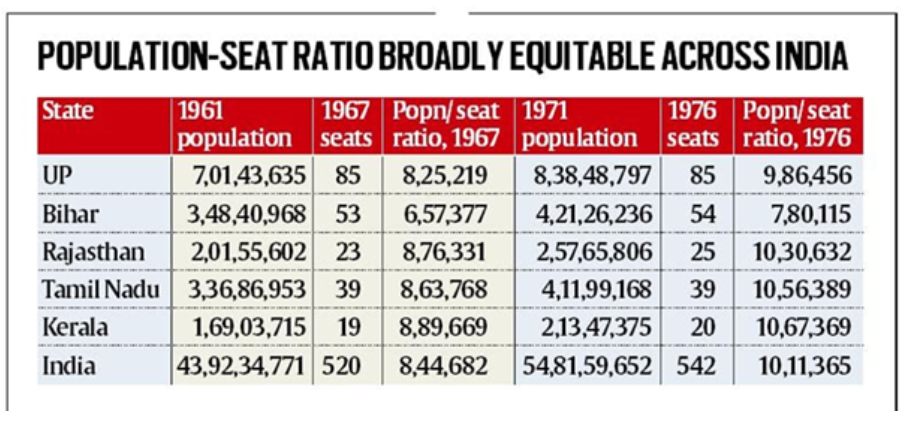
Kaobal Gali-Mushkoh Valley - Edukemy Current Affairs
In News: Kaobal Gali-Mushkoh Valley, once a battleground during the Kargil war, has now opened up for tourists.
About:

- This transformation is attributed to the enduring ceasefire between India and Pakistan sparking hope that tourism-driven commerce will thrive in the region.
Kaobal Gali-Mushkoh Valley
- It is located in Kargil’s Drass Sector and was a battlefield during the 1999 Kargil war between India and Pakistan.
- The region includes the Gurez Valley in north Kashmir, which was previously inaccessible to civilians due to shelling from Pakistan but now connects with the Mushkoh Valley in Kargil’s Drass Sector.
- Kaobal Gali, the highest pass at a height of 4,167 meters in Gurez, connects Gurez to Mushkoh Valley.
Gurez Valley
- The Gurez Valley is close to the Line of Control (LoC), in north Kashmir, with the Kishanganga river demarcating the line in several parts.
- It is also home to ibex, musk deer and marmots, Himalayan brown bear and snow leopard.
- The Gurez valley is one of few habitations in Kashmir where villages with only log houses exist, with no intervention of urban concrete materials.
Mushkoh Valley
- The Mushkoh Valley is situated in Dras, Ladakh.
- It is home to boisterous wild tulip flowers and endangered Himalayan yew.
EXERCISE YUDH ABHYAS-23 - Edukemy Current Affairs
In News: The 19th edition of “EXERCISE YUDH ABHYAS” is scheduled to take place from 25th September to 8th October 2023 in Fort Wainwright, Alaska, USA.
About:

- It is an annual exercise conducted jointly by the Indian Army and the United States Army.
- The previous edition of the Exercise was conducted in Auli, Uttarakhand, India in November 2022.
- Yudh Abhyas training includes various types of technical and operational activities exchanged between the armies of India and the United States.
- The theme of the EXERCISE YUDH ABHYAS-23 is ‘Employment of an Integrated Battle Group in Mountain/ Extreme Climatic Conditions’ under Chapter VII of the United Nations mandate.
Key Features:
- The exercise will feature a Command Post Exercise, as well as Expert Academic Discussions on specific topics.
- The Field Training Exercise will validate Integrated Battle Groups against hostile forces at the Brigade level, Integrated Surveillance Grid at the Brigade/Battalion level, and the use of Heliborne/Airborne elements and Force Multipliers.
- It will also assess logistics and casualty management during operations, evacuation, combat medical aid, and other aspects relevant to High Altitude Areas and Extreme Climatic Conditions.
- The Exercise will also involve the exchange of views and best practices in drills on a wide spectrum of combat skills including combat engineering, obstruction clearance, mine and Improvised Explosive Devices warfare.
The State of the Rhino Report, 2023
In News: Recently, the International Rhino Foundation (IRF) has released the “State of the Rhino, 2023” report, which provides population estimates and trends for the five remaining rhino species in Africa and Asia.
About:
- Every year, World Rhino Day is observed on 22nd September to spread awareness for all five species of rhino and the work being done to save them.
- It was first announced by the World Wildlife Fund (WWF) - South Africa in 2010.
Key Findings of the Report:
- According to the report, the two most significant factors causing rhino populations to decline are poaching and habitat loss, but climate change is also increasingly impacting many facets of their survival.
- Poaching still threatens all five rhino species -- black, white, greater one-horned, Sumatran, and Javan -- and has increased in several regions that had not previously been targeted.
- The collaboration among India, Bhutan, and Nepal, along with strict government protection and management, has led to a 20 percent increase in their population over the past decade. India is estimated to be home to 3,262 rhinos.
- Black rhino populations are increasing despite poaching pressure. However, South Africa is grappling with devastating poaching losses of its white rhinos, particularly in certain reserves.
- One concerning aspect highlighted in the report is that the status and whereabouts of 12 of the approximately 76 remaining Javan rhinos are unknown. Sumatran rhinos are also increasingly difficult to find, raising uncertainty about their population in the wild.
- The report underscores the need for continued efforts to protect and conserve rhinos and their habitats, address poaching, and mitigate the effects of climate change to ensure the survival of these iconic species.
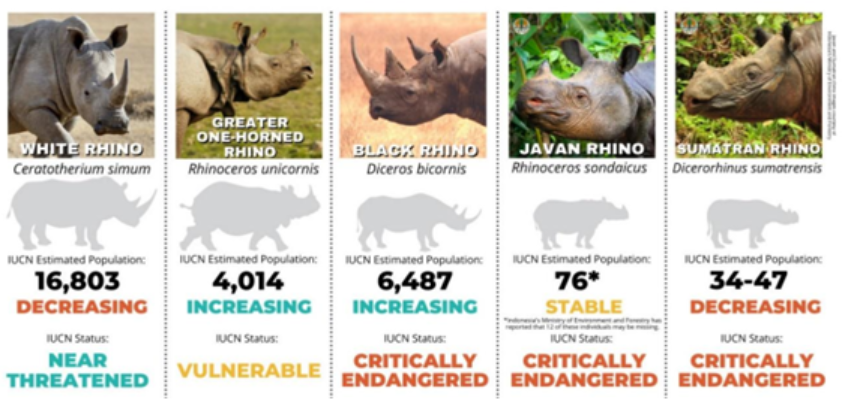 https://www.theweek.in/wire-updates/national/2023/09/20/del34-rhino-population-report.html
https://www.theweek.in/wire-updates/national/2023/09/20/del34-rhino-population-report.html
Veerangana Durgavati Tiger Reserve
In News: Recently, Madhya Pradesh, which is home to the most number of tigers in the country, has got a new protected area for the big cats named ‘Veerangana Durgavati Tiger Reserve’, the seventh in the state.
About:
- Veerangana Durgawati Wildlife Sanctuary is spread across Sagar, Damoh, and Narsinghpur districts of Madhya Pradesh.
- It is the seventh tiger reserve in Madhya Pradesh.
- Area: 2,339 square kilometers.
- Naming: It is named after Rani Durgavati, a queen of the Gondi people.
- Culture: The Singorgarh Fort can be found inside the reserve.
- It will encompass areas within the Nauradehi Wildlife Sanctuary and Durgavati Wildlife Sanctuary.
- A green corridor linking Panna Tiger Reserve (PTR) with Durgavati will be developed for the natural movement of the tiger to the new reserve.
- Rivers: Some areas of the reserve are situated in the Narmada and Yamuna River basins.
- Vegetation: Dry deciduous type
- Flora: The chief floral elements include Teak, Saja, Dhaora, Ber, Amla, etc.
- Fauna: Tiger, leopard, wolf, jackal, Indian fox, striped hyena, Nilgai, Chinkara, Chital, Sambhar, Black Buck, Barking deer, Common Langur Rhesus Macaque, etc.
More Information:
- Madhya Pradesh has consistently held the title of the “tiger state,” with its tiger population increasing from 526 in 2018 to 785 in the 2022 census.
Galactic tides - Edukemy Current Affairs
In News: Like the earth’s oceans at their shores, the universe’s galaxies also experience tides, on a larger scale.
About
- The gravitational forces within galaxies that result from interactions between celestial objects like stars and gas clouds are what drive galactic tides, which are similar to the tides in Earth's oceans but on a much larger scale.
- The evolution of galaxies is significantly shaped by these tidal forces. By forming features like tidal tails and bridges, promoting star formation, and upsetting smaller star systems, they can change the structure of a galaxy.
- Galactic tides over long periods of time also disturb star orbits, resulting in long-term modifications in galaxy structure. Even the interactions between nearby galaxies are influenced by galactic tides.
- Supermassive black holes at the centers of galaxies are also affected by galactic tides, which results in events that change how these cosmic giants interact with nearby stars.
One Health - Edukemy Current Affairs
Exam View: Climate change, more infections; Surveillance and reporting; One Health.
Context: In its latest report, the Intergovernmental Panel on Climate Change (IPCC) delivers a stark warning that climate change heightens the global risk of infectious diseases.
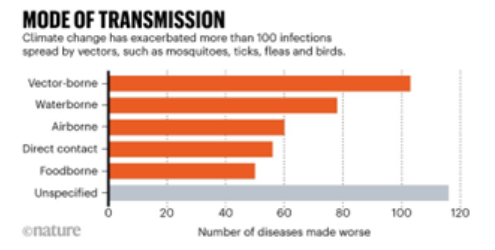 Decoding the editorial: Climate change, more infections
Decoding the editorial: Climate change, more infections
- Mosquito-borne disease outbreaks:
- The periodicity no longer follows expected patterns.
- Dengue manifests in two to three peaks throughout the year.
- Variability in temperature, precipitation, and humidity disrupt disease transmission cycles.
- These also alter the distribution of the vectors and animal reservoirs that host the parasite.
- Heat has been proven to interfere with the genomic structure of pathogens, changing their infectivity and virulence.
- Human-animal interaction:
- Habitat loss forces disease-carrying animals to encroach upon human territory, increasing the risk of human-animal interaction and the transfer of pathogens from wildlife to humans.
- Viruses which do not harm animals can be fatal for humans.
- Nipah virus, which has been causing outbreaks in Kerala for many years now, is a good example.
- Infectious diseases:
- An analysis of 2022 published in Nature Climate Change warns that humans now face a broader spectrum of infectious agents than ever before.
- Over half of all-known infectious diseases threatening humans worsen with changing climate patterns.
- Diseases often find new transmission routes, including environmental sources, medical tourism, and contaminated food and water from once-reliable sources.
- Invasive species:
- While ecosystems shape local climates, climate change is transforming ecosystems.
- This dynamic introduces invasive species and extends the range of existing life forms.
- Both these trigger upheavals in ecosystems that are complex and confound ecologists and epidemiologists to predict outbreaks.
Surveillance and reporting
Over the past two decades, India has improved its reporting of outbreaks.
- The Integrated Disease Surveillance Programme (IDSP)
- It was rolled out in a few States in 2007.
- From reporting 553 outbreaks in 2008, it last reported 1,714 in 2017.
- The Integrated Health Information Platform (IHIP)
- IDSP was phased out in favour of a new, web-enabled, near-real-time electronic information system called IHIP.
- It was launched in seven States in 2018.
- It added 20 additional disease conditions over IDSP’s 13 and could present disaggregated data to its users.
- Tragically, the programme, which would have enabled real-time tracking of emerging disease outbreaks, has not delivered on expectations.
- The current design of surveillance is not adequate for the emerging disease scenario.
One Health
- Meaning:
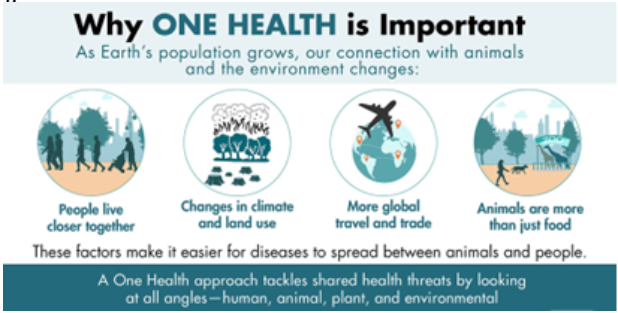
-
- A unified approach, termed One Health which integrates monitoring human, animal, plant, and environmental health, recognises this interconnectedness.
- Objective:
- This approach is pivotal in preventing outbreaks, especially those that originate from animals.
- It encompasses zoonotic diseases, neglected tropical diseases, vector-borne diseases, antimicrobial resistance, and environmental contamination.
- India’s strategy for one health:
- India must launch One Health and infectious disease control programmes by building greater synergies between the Centre and States and their varied specialised agencies.
- Animal husbandry, forest and wildlife, municipal corporations, and public health departments need to converge and set up robust surveillance systems.
- They will need to build trust and confidence, share data, and devise logical lines of responsibility and work with a coordinating agency.
- So far, the Office of the Principal Scientific Adviser to the Prime Minister has been taking this lead but with new World Bank and other large funding in place, this will need greater coordination and management.
Globally, there is an obsession with the enigmatic “disease X,” but it is the familiar annual cycles of known agents such as influenza, measles, Japanese encephalitis, dengue, diarrhoea among others that will continue to test the public health system. The re-emergence of Nipah in Kerala is a wake-up call, that mere biomedical response to diseases is inadequate. Embracing the One Health paradigm is our best defence.
Share the article
Edukemy’s Current Affairs Quiz is published with multiple choice questions for UPSC exams
MCQ
Get Latest Updates on Offers, Event dates, and free Mentorship sessions.

Get in touch with our Expert Academic Counsellors 👋
FAQs
UPSC Daily Current Affairs focuses on learning current events on a daily basis. An aspirant needs to study regular and updated information about current events, news, and relevant topics that are important for UPSC aspirants. It covers national and international affairs, government policies, socio-economic issues, science and technology advancements, and more.
UPSC Daily Current Affairs provides aspirants with a concise and comprehensive overview of the latest happenings and developments across various fields. It helps aspirants stay updated with current affairs and provides them with valuable insights and analysis, which are essential for answering questions in the UPSC examinations. It enhances their knowledge, analytical skills, and ability to connect current affairs with the UPSC syllabus.
UPSC Daily Current Affairs covers a wide range of topics, including politics, economics, science and technology, environment, social issues, governance, international relations, and more. It offers news summaries, in-depth analyses, editorials, opinion pieces, and relevant study materials. It also provides practice questions and quizzes to help aspirants test their understanding of current affairs.
Edukemy's UPSC Daily Current Affairs can be accessed through:
- UPSC Daily Current Affairs can be accessed through Current Affairs tab at the top of the Main Page of Edukemy.
- Edukemy Mobile app: The Daily Current Affairs can also be access through Edukemy Mobile App.
- Social media: Follow Edukemy’s official social media accounts or pages that provide UPSC Daily Current Affairs updates, including Facebook, Twitter, or Telegram channels.

